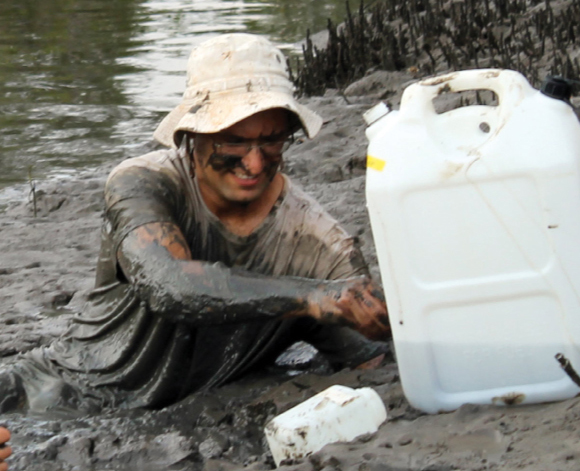Flood Chasers Monitor Water Quality in a New Way

Professor Santos working in the field. (Credit: http://www.barefootbiogeochemistry.com/new-page-42)
Forget storm chasers; if you’re interested in water quality, flood chasers are the ones to watch. Right now, a team of researchers from Southern Cross University led by Professor Isaac Santos, an ecohydrologist, are in the midst of a large-scale flood chasing project that will span several years. Recently, the team focused on Coffs Creek and Hearnes Lake, an estuary setting.
Professor Santos corresponded with EM about the project.
“’Australia is the land of droughts and flooding rains’” quotes Dr. Santos. “Floodwaters and the groundwater that seeps out of aquifers after floods keep rivers alive and release nutrients that drive fisheries in nearshore waters. Floods are the ‘hot moments’ that cannot be missed if we want to build a clear picture of water pathways in rivers and estuaries. We have done many flood-chase experiments in the last 9 years; this is the first time we focus on an estuary.”
The team of flood chasers rapidly take huge numbers of samples before, during, and after rain events to examine chemical, gas, and metal levels before, during, and after floods. Ultimately, the team analyzes thousands of data entries, determining levels of carbon, nitrogen, phosphorus, and radon going into surface waterways from aquifers, rains, and the ocean.
When the chasers take action, they have to be decisive. Lost minutes mean lost data.
“Flood-chase experiments are often a gamble of our time and resources,” explains Dr. Santos. “We have to mobilize quickly and rely on the weather forecast to get pre-flood data. We took the gamble last week [the first week in March 2018] and got a lovely rain event that was both insightful and safe for our researchers and equipment—we managed to get lots of samples from three different sites with appropriate resolution.”
The team has what is essentially a mobile laboratory complete with automated instruments; these are the tools that do the intensive work of collecting samples every minute during a storm. The question the flood chasers are addressing now is whether mangroves are effective enough to improve water quality even during flood events with extremely rapid water movement.
“We chose the sites based on our earlier research on creeks and headwater streams,” details Dr. Santos. “We wanted to see how the flood water propagates from headwaters across estuaries into the ocean. We know that mangroves are efficient at improving water quality in estuaries; mangroves filter catchment pollution.”
The team measures nutrient levels in the water, but that’s not the end of their analysis.
“We also measure greenhouse gases and chemical tracers of groundwater seepage such as radon,” Dr. Santos describes. “Floods recharge aquifers, and the aquifer out seeps out into the estuary soon after floods recede. Radon tells us when groundwater comes into play with a different type of chemistry.”
The techniques the team is using on Coffs Creek and Hearnes Lake are transferable to other waterways, even incredibly dynamic systems like this estuary.
“Our techniques have now been used in a number of waterways,” remarks Dr. Santos. “Estuaries are tidal and change very quickly. Previous research relied on smaller datasets because sampling is labour intensive. Floods come and go quickly. Our automated techniques help to build comprehensive datasets that capture the major hydrological transitions.”

A view of Coffs Creek. (Credit: Paul Lakin) [CC BY 3.0 (http://creativecommons.org/licenses/by/3.0)]
While automation of the process is making the work easier, it also presents the team with new hurdles to clear.
“The concept of automation is exciting and is quickly replacing some lab-based methods,” Dr. Santos explains. “However, automation brings lots of challenges, including the processing of very large datasets that requires a different type of skill. The quality of data we get in the field for certain parameters such as greenhouse gases is now better than the quality of data we would get from discrete samples analyzed in the lab.”
In this stunningly beautiful region there is a tremendous range of sites and waterways for water quality researchers to explore, from ocean to mangrove to freshwater areas—a true paradise for flood chasing.
“Our region is indeed stunning and quite prone to flood events,” Dr. Santos confirms. “We have done flood-chase experiments in headwater streams, acid sulphate soils, freshwater wetlands, rivers, and now in estuaries. We have a large group of researchers and students working on similar topics. We plan to go offshore next time to capture how floods may drive phytoplankton blooms and ultimately enhance fisheries.”





0 comments